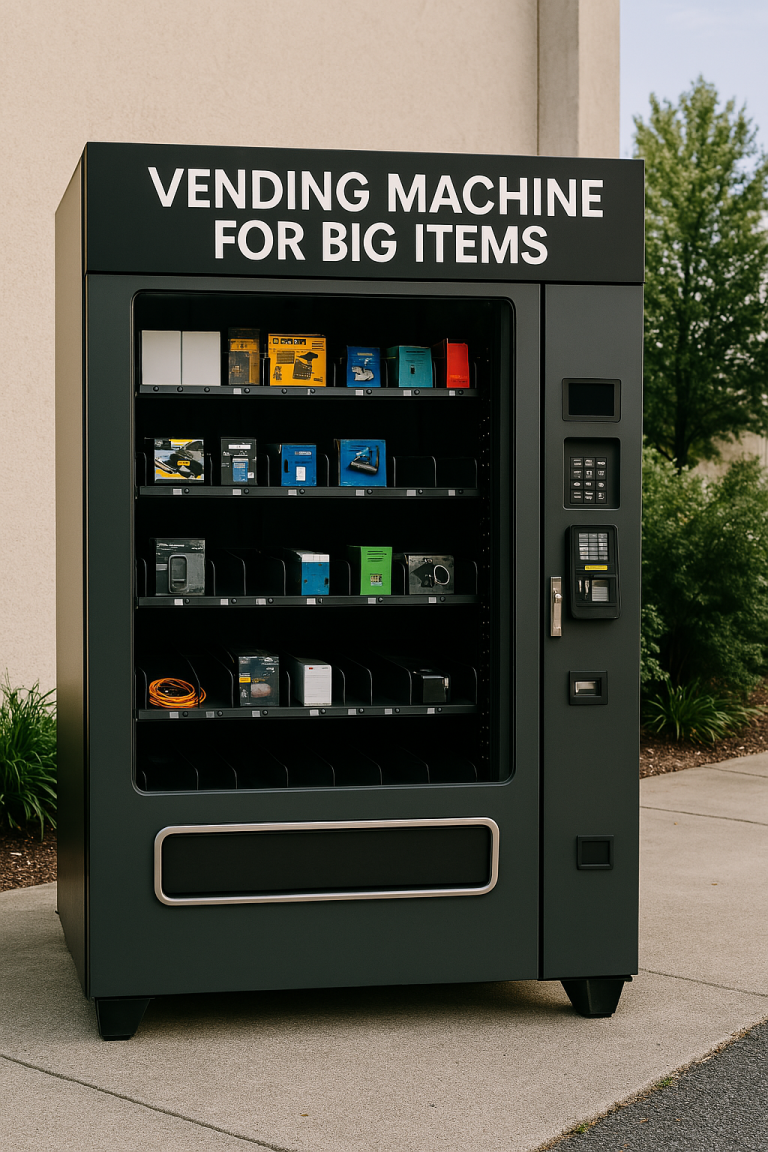Our vending machines are built to order with a 45-60 day lead time. Flexible Financing Options available starting at less than $100/mo. Apply for Financing
Ensuring Safety and Hygiene: Best Practices for Vending Machine Maintenance
In an era where hygiene has become paramount, vending machine hygiene practices are not just an option but a necessity. This article delves into the pivotal role of cleanliness in vending machine maintenance, offering actionable tips to ensure the safety of both products and consumers.
Implementing Routine Cleaning Protocols
Routine cleaning is the first line of defense in vending machine hygiene. Establishing daily, weekly, and monthly cleaning schedules can prevent the buildup of dirt and bacteria. Daily tasks should include wiping down surfaces and handles with disinfectant, while more thorough internal cleanings can be reserved for weekly routines.
The materials used for cleaning are just as important as the schedule. Utilize cleaning agents that are effective against a broad spectrum of bacteria without damaging the vending machine’s components. Choose materials based on their efficacy and safety to ensure they don’t leave harmful residues that could contaminate products.
Documentation of cleaning schedules and protocols is crucial for maintaining consistent hygiene standards. Keeping records not only helps in ensuring that the cleaning tasks are completed on time but also aids in accountability. Periodic audits of the logs can help in identifying areas for improvement and ensuring compliance with health regulations.
Sanitization Techniques for Vending Machine Safety & Hygiene
Sanitization goes beyond basic cleaning by targeting and reducing pathogens to safe levels. Focusing on high-touch areas like selection buttons and product dispensers is essential. Sanitizing these frequently touched surfaces helps minimize the risk of cross-contamination and the spread of germs.
In today’s tech-savvy world, consider introducing touch-free payment and selection options to reduce physical contact with the machine. These technologies complement sanitization efforts by limiting the need for direct interaction, thereby enhancing the overall safety of the vending experience.
Training staff on the correct sanitization procedures ensures that the practices are not just carried out, but done so effectively. It’s important for the personnel to understand the difference between cleaning and sanitizing and to be aware of the specific products and methods to use for optimal results.
Advanced Vending Machine Hygiene Practices and Customer Trust
Implementing advanced hygiene measures such as UV-C light disinfection systems can provide an added layer of protection. These systems can be integrated into vending machines to regularly disinfect the product dispensing area, instilling greater confidence in consumers about the safety of the products they are purchasing.
Transparent communication with customers about the hygiene practices in place can significantly bolster trust. Displaying certificates of sanitation, hygiene checklists, or even digital counters showing the last cleaning time can assure customers of the vending machine’s cleanliness.
Innovations in vending machine design can also contribute to enhanced hygiene. Machines that minimize product exposure and require less direct contact can prevent contamination and promote a hygienic vending environment. Considering such designs in new machines or retrofitting existing ones can be a proactive approach to hygiene.
Regular Maintenance and Inspection
Regular maintenance extends beyond cleaning, addressing the mechanical aspects of vending machines. Checking and servicing the coin mechanism, bill validator, and touchscreen interfaces can prevent the accumulation of grime and the spread of bacteria. It’s not just about cleanliness but also ensuring that the machines function without a hitch, reducing the need for customers to touch surfaces multiple times due to a malfunction.
Inspection should be a part of the maintenance routine. A visual check for any signs of contamination or product spoilage can go a long way in maintaining hygiene standards. This includes examining the expiration dates of products and ensuring that the vending machine’s refrigeration system, if present, is functioning correctly to keep perishable items fresh.
Engaging a professional service for quarterly or bi-annual deep cleanings and inspections can maintain optimal hygienic conditions. These services can address areas that are not regularly accessible and can handle the safe disposal of expired or contaminated products, ensuring that the vending machine remains a safe source of goods.
Smart Vending Machine and Hygiene Monitoring
The advent of smart vending machines has introduced the possibility of real-time hygiene monitoring. Sensors can detect and alert operators to any irregularities in temperature, which could affect product freshness and safety. Additionally, smart technologies can monitor the usage patterns of the machine, prompting timely cleanings based on actual need rather than a set schedule.
Connectivity can also improve hygiene practices. With IoT-enabled vending machines, operators can receive notifications on their devices for scheduled cleanings, inventory checks, and maintenance alerts. This proactive approach ensures that machines are attended to promptly, maintaining a high standard of hygiene at all times.
Customer interaction with smart vending machines can also be a source of valuable feedback. Incorporating quick response (QR) codes that customers can scan to report any hygiene issues can empower them to be part of the solution, ensuring that the machines meet their expectations for cleanliness.
Hygiene Training for Operators
Operators are at the forefront of maintaining vending machine hygiene. Providing comprehensive training on the latest hygiene and safety protocols ensures that they are equipped to handle the machines appropriately. This includes understanding the correct use of cleaning agents, the importance of wearing protective gear, and the best practices for preventing contamination.
Regular refresher courses can keep operators up to date with the latest hygiene standards and regulations. With the constant evolution of health and safety guidelines, especially in response to events like the COVID-19 pandemic, staying informed is critical.
Empowering operators with knowledge not only about ‘what’ to do but also ‘why’ it’s important can foster a culture of cleanliness. When operators understand the impact of their actions on consumer health and business reputation, they are more likely to adhere to the best practices for vending machine hygiene.
Sanitization Protocols and Public Health
In a world where public health has taken center stage, sanitization protocols for vending machines are not just routine; they’re a public service. This involves not just cleaning but ensuring that every surface that could be touched by consumers is disinfected. Utilizing products that are effective against a broad spectrum of pathogens is essential.
The frequency of sanitization becomes even more critical in high-traffic areas. It’s not enough to sanitize daily; in locations like airports or train stations, a schedule that includes multiple cleanings throughout the day may be necessary. It’s about being responsive to the flow of people and the potential for germ transmission.
Providing hand sanitizing stations near vending machines can also be a part of the hygiene protocol. It’s a step that shows a commitment to customer health and encourages hygienic practices before and after using the vending machine. Such measures can play a significant role in preventing the spread of infectious diseases.
Contactless Payment and Touchless Technology
The rise of contactless payment options has been a boon for vending machine hygiene. Allowing consumers to pay with a smartphone or contactless card greatly reduces the need for physical interaction with the machine.This shift not only meets a demand for convenience but also supports a more hygienic transaction process.
Touchless technology extends beyond payment. Vending machines now come equipped with motion sensors that allow users to make selections through gestures instead of touch. This advancement is an excellent example of how technology can adapt to meet hygiene needs in a post-pandemic world.
Investment in touchless technology is an investment in consumer confidence. As customers become more conscious of the surfaces they touch, vending machines that minimize or eliminate the need for contact can stand out in the market. This technology not only enhances hygiene but can also serve as a competitive advantage in the retail space.
Conclusion
Maintaining the hygiene of vending machines is not only about keeping the machines clean but also about safeguarding public health and maintaining consumer trust. By implementing a robust regimen of cleaning, sanitizing, and leveraging advanced hygiene technologies, vending machine operators can ensure their machines are not just vending snacks and beverages, but also delivering safety and peace of mind.



